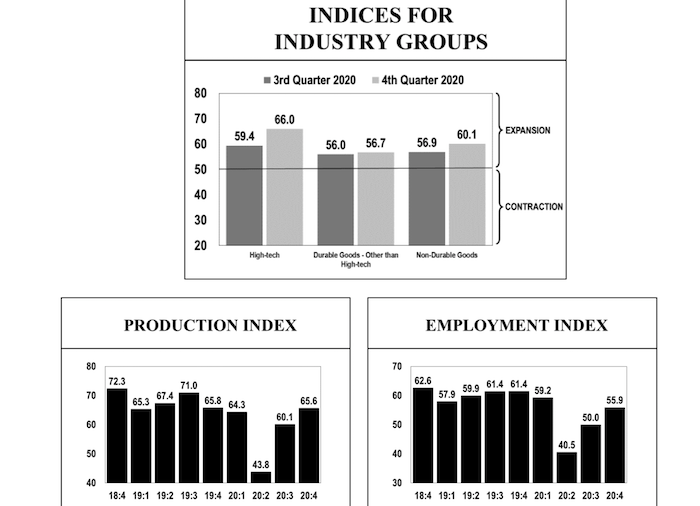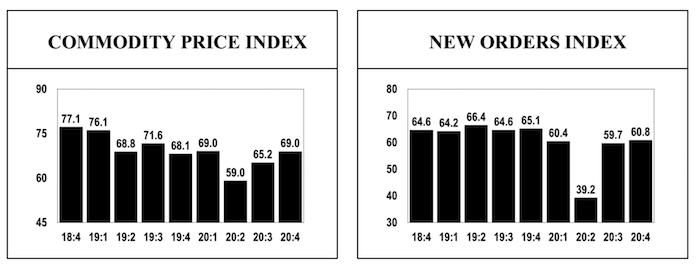

Comments by the Purchasing Managers
Very difficult getting people in California to work. Unemployment easier than working. (Food)
We expect seasonal changes – we sell more of our wine stock in the holiday season. (Beverage & Tobacco Products)
Freight is ridiculously slow and overpriced. We had been increasing orders, but the lack of the $600 will cause a slowdown. People aren’t getting what they need to make purchases. (Textile Mill Products)
Our inventory is way up – we are stuck with everything. We have half the employees we had in March. (Apparel)
Due to a myriad of issues, including the challenges of operating a manufacturing plant in CA, we will be closing our operations during the quarter. Volume has been negatively impacted by the pandemic, compounding the challenges of a fragile business model here. (Paper)
Production will be better because of the election. We are buying more because of the election, but expect to sell it all. We will be hiring more for the election. (Printing & Related Support Activities)
We are seeing a rebound in new orders and new customers. Along with this, longer lead times on raw materials and an increase in costs. Our customers seem nervous and want to book and receive their orders just in case there is a downturn in the supply chain or demand. (Chemicals)
We have seen prices rise due to freight and raw material increases. We have a seen a slow recovery in our markets outside of PPE and barrier work. We don’t expect the barrier material to increase until after schools return to in class study. (Plastics & Rubber Products)
Supplying lumber for the building sector is going to be strained in the final quarter. Wildfires and COVID-19 closures are driving the supply side and prices to extreme heights! (Wood Products)
We expect the residential renovation sector to stay strong through the winter as homeowners continue to spend money on their homes rather than on travel. We are adjusting our model to meet this change. (Nonmetallic Mineral Products)
With the impact of Covid-19 we have slowed down. We manufacture for all types of industries but primarily in Aerospace. This has slowed down since planes are not in demand at this time. (Primary Metals)
100% of our customers slow down with new orders. (Fabricated Metal Products)
We are starting to see more of a recovery taking place. The election will likely blip up or down but overall we are doing unexpectedly well. We had a few people leave during the downturn, and we are now working on getting replacements after holding off to see what was going to happen. (Machinery)
Very tumultuous times. Hard to see ahead. Many surprises for all sorts of reasons. On balance, current projects are deteriorating but new opportunities are emerging leaving a revenue gap we need to bridge over the next 6 to 9 months. (Computer & Electronic Products)
We won’t hire anyone new now – if we have too much work, we’ll go to overtime. (Electrical Equipment, Appliance & Components)
The ports are experiencing HEAVY congestion and not enough employees reporting to work. The cargo volumes have increased drastically due to the lack of passenger belly space in planes. Due to the continued impacts of Covid-19, there is significant equipment and capacity shortages that are contributing to delays nationwide. (Transportation Equipment)
We have seen an uptick in business in the home furnishings industry. Retailers and designers are reporting a good amount of activity following the pandemic related closures. (Furniture & Related Products)
Our industry is very volatile right now due to the government shutting down certain sectors and all of the civil unrest. Our state government continues to make terrible decisions that are really affecting our business and everyone else’s business that we’ve had meetings with. We’ve never had any thought of leaving the state but we’ve begun talking about that recently if things don’t improve soon. (Miscellaneous)
We’ve been very fortunate through this Covid-19 situation, it’s given us time to catch up on our 2-year backlog. The fact that we do very little business with Boeing is the main reason we haven’t closed. (Aerospace Products & Parts)
ABOUT THE ANDERSON CENTER FOR ECONOMIC RESEARCH
The A. Gary Anderson Center for Economic Research (ACER) was established in 1979 to provide data, facilities and support in order to encourage the faculty and students at Chapman University to engage in economic and business research of high quality, and to disseminate the results of this research to the community



















